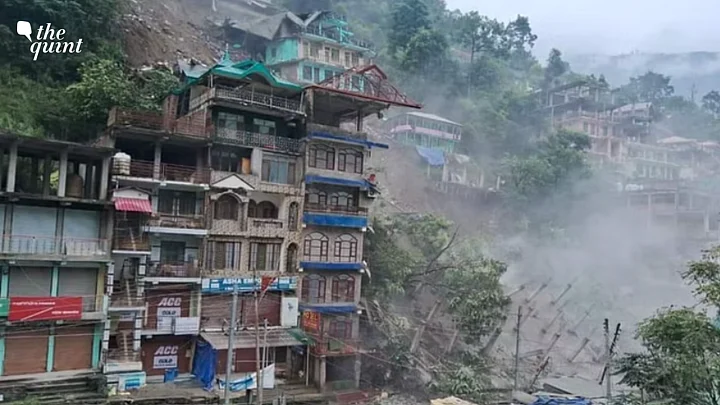The Quint spoke to eyewitnesses and experts to understand what happened in Himachal Pradesh and why exactly it happened.
Houses Razed, 'Left With Nothing': Victims Say
Gyan Chand, Vidya Devi, Shashi Bala, Suresh Kumar, Chiranji Lal, Khem Prakash, Laik Ram, and Tule Ram lost their houses in the landslide in Ani. Yupendra Kant Mishra and Fakir Chand’s houses are in ‘danger’.
The victims say that they had spent their entire lifetime's earnings on their homes. But now they have been razed, with nothing left with them.
“We have demanded relief from the government and the administration,” they told The Quint.
After these eight houses collapsed, the district administration declared 23 more houses unsafe and has issued a notice to vacate them. About two dozen houses have been declared to be in the ‘danger zone’.
Ani’s SDM Naresh Verma said that three buildings at the hill’s forward end and four buildings towards the backside had fallen too. Cracks had started to appear in many other buildings too due to frequent landslides.
No one lost their lives and a bigger disaster was averted due to the administration’s initiatives.
The district collector of Kullu told The Quint that
Rs 20,000 have been given to victims for immediate relief
Arrangements have been made for the victim’s stay at government relief camps and schools
Food and lodging have been arranged for all affected people
But How Did These Buildings Collapse?
Himachal Pradesh has been witnessing continuous rainfall since 24 June. Heavy rains leashing the region turned disastrous on 9 July and have been wreaking havoc since.
Kullu, Mandi, Shimla's Summerhill, and Krishna Nagar were the first to be affected, with Kullu’s Ani now joining the list.
Experts say that due to the rain, the land has become waterlogged. Add to this, the construction of multi-storeyed buildings on weaker grounds.
“The land gets washed away like a swamp when waterlogging happens,” experts say.
Dr Seema Chowdhary, Professor and Researcher, Department of Geography, at Shimla’s Himachal Pradesh University, said that many houses have been built here without planning, land investigation, structure design, and without considering drainage and retaining walls.
“In such a situation, after continuous rains, the water in many houses is seeping from place to place. A Nagar Panchayat was formed to bring such dangerous constructions in Ani town back on track in a planned manner, so that the houses are constructed under TCP guidelines, but that was cancelled.”Dr Seema Chowdhary
With many multi-storeyed houses in Ani, researchers also say that the mountains are overwhelmed with more burden (overcrowding) than they can handle. Dr Chowdhary says,
“More than 30,000 houses are being built in Shimla city without geological survey and its consequences are going to be worrisome in the coming years.”
These consequences are already being seen in terms of landslides and cloud bursts leading to loss of lives, economic losses, etc.
According to Chief Minister Sukhwinder Singh Sukhu,
The state has incurred losses of over Rs 12,000 crore due to heavy rainfall.
Construction material from under-construction bridges worth lakhs of rupees has been washed away.
Roads to many villages are broken.
2,346 houses have been completely destroyed.
10,135 houses have been damaged.
5,048 gaushalas have been damaged.
303 shops have been damaged.
The PWD has suffered a loss of over Rs 2,828 crore.
The Jal Shakti Department incurred losses of over Rs 2,000 crore.
The electricity board suffered damages of over Rs 1,731 crore.
Population & Construction Major Evils
The population pressure on Shimla is a significant cause of concern. Shimla Municipal Corporation records from 1864 show that back then, the population of the city used to be in hundreds. Soon after, the city was developed and made habitable for only 25,000 people.
However, statistics today show a grim picture:
In 2011, Shimla’s population had crossed 1,65,000.
Presently, it stands at 2,80,000.
HPU’s Geography Departments predicts that by 2041, the population is likely to reach 4,15,000. When that happens, Shimla won’t have adequate space for necessities like drinking water, parking, or sewers.
With parking and roads being limited in Shimla, the increasing number of vehicles is also a major headache for the administration.
Number of vehicles in Shimla in 2005: 19,849
Number of vehicles in Shimla in 2021: 70,131
Current number of vehicles in Shimla: Over 1.3 lakh
A survey conducted by the Geography Department of HPU Shimla in 2021 revealed that the way the city's population is increasing, its consequences are going to be very worrying in future.
Dr Chowdhary points out that along with population and overcrowding, the other bigger concern is mindless construction.
“In Shimla, houses have been built at many such places where there were drains or a channel of light water in the past. The problem is that the direction of the water cannot be changed with the will of man. If not today, then tomorrow, it becomes a cause of trouble. And people use JCBs or cutters to build houses, whose vibration weakens the foundation.”Dr Seema Chowdhary
Himachal's Geological expert and IAS officer Dr SS Guleria concurs.
He tells The Quint, "Houses are not being built in Shimla with soil conservation methods. Due to this, land erosion is increasing due to the construction of houses and the land is not able to bear much burden.”
Demand To Declare Situation in Himachal A National Disaster
With continuous heavy rainfall, cloud bursts, and landslides, many regions in Himachal have come to a standstill.
Over 700 roads, including the Chandigarh-Shimla and Chandigarh-Manali highways, are closed. Eleven people have died in the last 36 hours, including two children. Since 24 June 24, 362 people have died.
The situation in Himachal has been declared a state disaster, but leaders are now raising the demand for it to be declared as a national disaster. Congress leader Priyanka Gandhi also tweeted and demanded the Centre to declare the disaster that hit the state as a matter of national concern.
